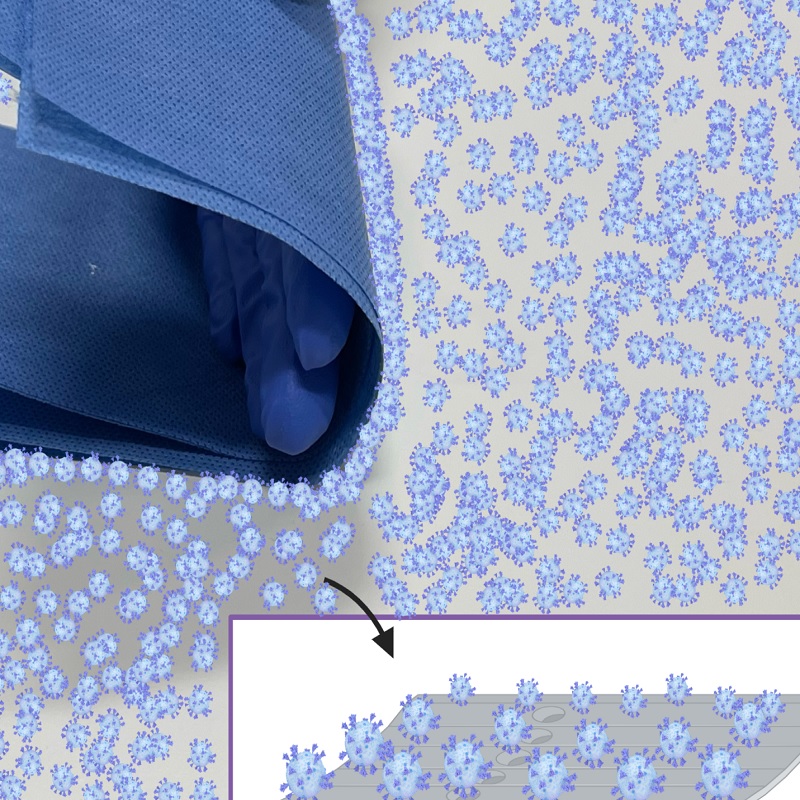The latest Interface Focus issue highlights the role of different surfaces in the transmission of the SARS-CoV-2 virus.

A new Interface Focus issue sheds light on how different materials and their properties affect how long the SARS-CoV-2 virus can survive on different surfaces. We spoke to the organiser, Professor Mohan Edirisinghe, about the importance of tailoring PPE and packaging to reduce the survival of the virus, as well as considering green usage strategies.
1) What are the aims of the issue?
This issue highlights the role of different surfaces in the transmission of the SARS-CoV-2 virus. It has been discovered that the virus can linger on surfaces for a very long time, helping facilitate transfer between people when surfaces are touched. The papers in the special issue shed light on how long the virus can survive on different surfaces and whether we can we use this information to tailor surface properties. For example, it is important to investigate whether surface porosity (the ability of liquids to pass through surfaces) can help, as well as whether the basic type of material (metal, ceramic, polymer) can have a significant effect. Understanding the factors that affect the survival of the SARS-CoV-2 virus on different surfaces can also come into play during the creation of packaging, however, when selecting materials, we need to consider issues like sustainability and the environment, which are becoming increasingly important at the present time. Cleaning protocols and standards for surfaces will also have to be modified and prescribed differently. A Headline Review on “Surface interactions and viability of coronaviruses” in the Journal of The Royal Society Interface in January 2021 will go hand-in-hand with the content of this special issue in defining the materials and products that should be used.
2) How does an understanding of textiles help the development of effective PPE and face masks?
It is clear that some types of textiles, such as polyester vis-à-vis cotton, are more accommodating for the virus, and the paper by Owen et al. clearly illustrates this point. It may be possible to cost-effectively include an anti-viral material such as very fine particulates on the surface of fibres to annihilate the virus in textiles, and this method could be used in the making of masks, as illustrated by Patil et al. However, the use of masks has the potential to be a huge future environmental issue, as disposal could cause even more hazards and problems compared to those that we currently encounter with typical plastics.
3) What can researchers working in other areas of COVID-19 research e.g. epidemiology, learn from this issue?
Both life and physical scientists can learn from this issue, since both research areas are vital in expanding our understanding and knowledge of the virus. The notion that vaccines and anti-viral therapies alone can combat this pandemic is ill-conceived. Of course, we need them, but we also need to adapt and adopt new practices, including a new emphasis on selecting material types and their surface textures. It is the combined physical and life sciences approach that will have the most impact on the spread of the virus.
4) How can we use these findings to combat infectious diseases or pandemics in the future?
What has become abundantly clear is that touching surfaces is a key feature in any virus-dominated disease. To combat this, we need the help of surface design, creation, and maintenance in common materials such as metals, plastics, glass and textiles to create materials that will hamper viral transmission. Using undulated surfaces with porosity can help reduce survival of the virus, as well as reducing material consumption and encouraging greener material usage.
Keep up to date with the latest issues of Interface Focus by signing up for content alerts, and browse previous theme issues on the journal website.
Image caption: The SARS-CoV-2 virus and its variants can survive on surfaces from a few hours to a few days, depending on the material type and surface characteristics. Therefore, it is important to carefully select surfaces to minimise the survival of the virus, and to implement proper cleaning procedures and use of personal protection equipment. Credit: Mehmet Aydogdu and Mohan Edirisinghe, created with BioRender.com.
